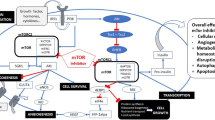Abstract
The evolution of immunosuppressive therapy toward synergistic drug combinations seeks to minimize toxicity while potentiating efficacy. Median effect analysis discerns synergistic drug combinations that may be suitable for in vivo experiments in animals and for subsequent clinical trials. These studies suggest that two drugs rapamycin (RAPA) and brequinar (BQR) display synergistic effects in combination with cyclosporine. This combination must be evaluated for relative toxicity versus efficacy. Clinical trials to assess the individual toxicities of RAPA and BQR are presently underway in order to discern appropriate doses for randomized trials of clinical efficacy.
Similar content being viewed by others
Abbreviations
- BMA:
-
Behringwerke monoclonal antibody
- BQR:
-
brequinar
- CI:
-
combination index
- CsA:
-
cyclosporine
- II:
-
interleukin
- MAb:
-
monoclonal antibodies
- NFAT:
-
nuclear factor of activated T-cell
- RAPA:
-
rapamycin
References
Brinker KR, Dickerman R, Gonwa T (1990) A randomized trial comparing double drug and triple drug therapy in primary cadaveric renal transplantation. Transplantation 50:43
Chou TC, Talaly P (1984) Quantitative analysis of dose-effect relationships: the combined effects of multiple drugs or enzyme inhibitors. Adv Enzyme Regul 22:27
Cramer D, Chapman FA, Jaffee BD, Jones EA, Knoop M, Eiras-Hreha G, Makowka L (1992) The fact of a new immuno-suppressive drug, brequinar sodium, on heart, liver and kidney allograft rejection in the rat. Transplantation (in press)
Didlake RH, Kim EK, Sheehan K, Screiber RD, Kahan BD (1988) Effect of combined antigamma interferon antibody and cyclosporine therapy on cardiac allograft survival in the rat. Transplantation 45:353
Drachman R, Schlesinger M, Shapira H, Drukker A (1989) The immune status of uremic children/adolescents with chronic renal failure and renal replacement therapy. Pediatr Nephrol 3:305–308
Fanslow WC, Sims JE, Sassenfeld H, Morrisey P, Gillis S, Dower S, Widmer M (1990) Regulation of alloreactivity in vivo by a soluble form of the interleukin-1 receptor. Science 147:739
Fanslow WC, Clifford K, Park I, Rubin A, Voice R, Beckmann M, Widmer M (1991) Regulating alloreactivity in vivo by IL-4 and the soluble IL-4 receptor. J Immunol 147:535
Fischer G, Wittmann-Liebold B, Lary K, Kiefhaber T, Schmid F (1989) Cyclophilin and peptidyl cis-trans isomerase are probably identical proteins. Nature 337:476
Hall BM, Jelbest ME, Dorsch SE (1984) Suppressor T cells in rats prolonged cardiac allograft survival after treatment with cyclosporine. Transplantation 37:595
Handschumacher R, Harding M, Rice J, Drugge R, Speicher D (1984) Cyclophilin: a specific cytosolic binding protein for Cyclosporine A. Science 226:544
Jorgenson W (1991) Rusting of the lock and key model for protein-ligand binding. Science 254:954
Kahan BD (1981) Drug therapy: cyclosporine. N Engl J Med 321:1725
Kahan BD (1985) Overview: individualization of cyclosporine therapy using pharmacokinetic and pharmacodynamic parameters. Transplantation 40:457
Kahan BD (1991) Synergism, how assessed and how achieved. Clin Transplant 5:534
Kahan BD (1992) Optimization of cyclosporine therapy with combinations of immunosuppressive agents. Transplant Proc (in press)
Kahan BD, Chang JY, Sehgal SN (1991) Preclinical evaluation of a new potent immunosuppressive agent, rapamycin. Transplantation 52:185
Kahan BD, Gibbons S, Tejpal N, Stepkowski S, Chou TC (1991) Synergistic interactions of cyclosporine and rapamycin to inhibit immune performances of normal human peripheral blood lymphocytes in vitro. Transplantation 51:232
Kupiec-Weglinski JW, Filho MA, Strom TB, Tilney NL (1984) Sparing of suppressor cells: a critical action of cyclosporine. Transplantation 38:97
Kurrle R, Seyfert W, Trautwein A, Seiler F (1985) Cellular mechanisms of T cell activation by modulation of the T3 antigen complex. Transplant Proc 17:880
Lindholm A, Albrechtsen D, Tufveson G, Karlberg I, Persson N, Groth C (1992) A randomized trial of cyclosporine and prednisolone versus cyclosporine, azathioprine and prednisolone in primary cadaveric transplantation. Transplantation 53 (in press)
Liu J, Farmer J, Friedman J, Weissman I, Screiber S (1991) Calcineurin is a common target of cyclophilin — Cyclosporin A and FKBP-FK50ß6 complexes. Cell 66:807
Miyagawa S, Stepkowski SM, Kahan BD (1991) Mechanism of unresponsiveness in rats induced by a short course of FK 506 or CyA. Transplant Proc 23:334
Platz KP, Sollinger HW, Hullett DA, et al, (1991) RS-61443 — a new, potent immunosuppressive agent. Transplantation 51:27
Ponticelli C, Tarantino A, Montagnino G (1988) A randomized trial comparing triple drug and double drug therapy in renal transplantation. Transplantation 45:913
Soullilou JP, Cantarovich D, LeMauff B (1990) Randomized controlled trial of a monoclonal antibody against the interleukin-2 receptor (33B3.1) as compared with rabbit antithymocyte globulin for prophylaxis against rejection of renal allografts. N Engl J Med 322:1175
Starzl TE, Todo S, Fung J, et al (1989) FK506 for human liver, kidney and pancreas transplantation. Lancet II:1000
Starzl TE, Fung J, Jordan M, et al (1990) Kidney transplantation under FK506. JAMA 264:63
Turka LA, Dayton J, Sinclair G, Thompson CB, Mitchell BS (1991) Guanine ribonucleotide depletion inhibits T cell activation: mechanism of action of the immunosuppressive drug mizorbine. J Clin Invest 87:940–948
Ullman KS, Flanagan WM, Cothesy B, Kuo P, Northrop JP, Crabtree GR (1991) Site of action of cyclosporine and FK506 in the pathways of communication between the T-lymphocyte antigen receptor and the early activation genes. Transplant Proc 23:2845
Van Duyne G, Standaert R, Karplus P, Screiber S, Clardy J (1991) Atomic structure of FKBP-FK506, an immunophilin-immunosuppressant complex. Science 252:839
Vathsala A, Chou TC, Kahan BD (1990) Analysis of the interaction of immunosuppressive drugs with cyclosporine in inhibiting DNA proliferation. Transplantation 49:436
Wüthrich K, Freyberg B, Weber C, Wider G, Traber R, Widmer H, Braun W (1991) Receptor-induced conformation change of the immunosuppressant cyclosporin A. Science 254:953
Author information
Authors and Affiliations
Rights and permissions
About this article
Cite this article
Kahan, B.D. New immunosuppressive drugs: Needs in and applications to pediatric transplantation. Eur J Pediatr 151 (Suppl 1), S9–S12 (1992). https://doi.org/10.1007/BF02125796
Issue Date:
DOI: https://doi.org/10.1007/BF02125796




